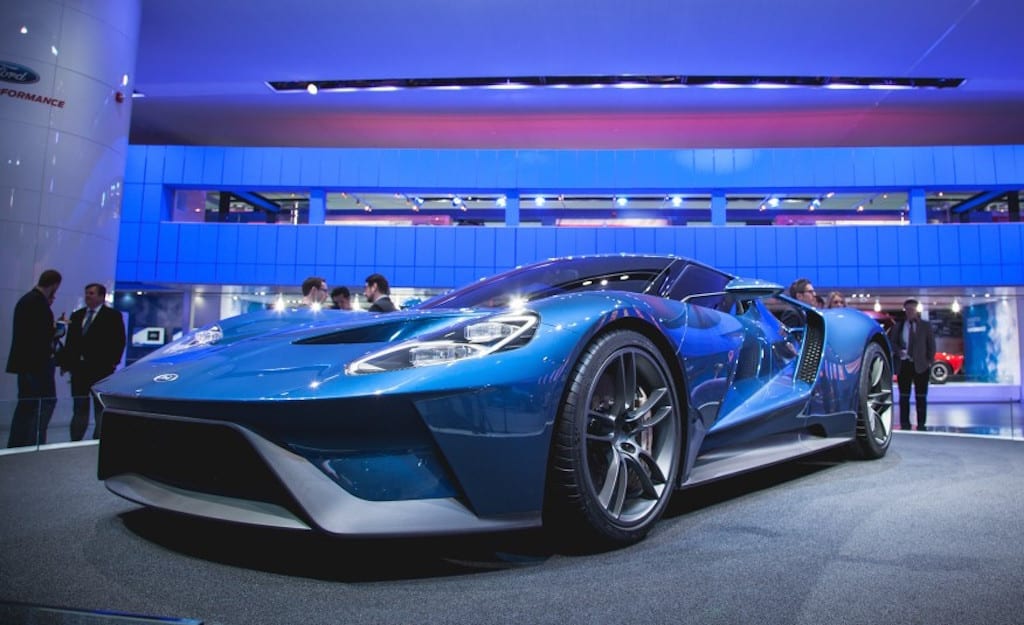The GT made a name for itself in the 1960s, and the nameplate returned to Ford for the 2005 and 2006 models. Since then, the vehicle has truly evolved into a supercar, evident by it’s $100,000+ price tag.
The company has made some changes to the third-generation GT, prioritizing handling and track capabilities in their 2017 model. The result? Not only one of Ford’s most impressive cars ever, but perhaps one of the most innovative cars to ever be released.
You probably won’t see this car sitting around any Ford dealers. However, if you have the money (and that’s a big if), you’ll still be itching to get behind the wheel of a 2017 GT…
It’s Powerful
When we say “powerful,” we’re not referring to the car’s ability to get up a hill. We’re also not referring to it’s class-leading horsepower specs. No, we’re talking about power, and we’re referring to it’s (almost) industry-leading horsepower specs.
The developers of the EcoBoost 3.5-liter V6 engine took advice from other Fords, as well as the “Roush Yates-built IMSA Daytona Prototype endurance racers,” as Dan Mihalascu of CarScoops.com described. They ultimately produced an engine that can produce up to 700 horsepower, and those specs would rival the Ferrari LaFerrari, Ferrari F12berlinetta, and Lamborghini Aventador for the cars with the highest amount of power.
Contributing to the GT’s impressive list of specs will be it’s expected curb weight and “power-to-weight ratio”, which Ford’s global performance vehicle chief engineer Jamal Hameedi expects to be the best on the market (told to Alexander Stoklosa of CarAndDriver.com). The car may get even lighter by the time it’s released, as engineers are reportedly testing the carbon-fiber and forged-aluminum wheels for the new supercar. The carbon-fiber wheels are considerably lighter, but the GT shown at the Detroit Auto Show featured the alternative.
To emphasize their dedication to producing a light car, Ford teamed up with Multimatic Motorsports and Engineering to develop light-weight (and low-cost) carbon-fiber body panels. All of the bodywork will be hand-laid, which just confirms the brand’s dedication to excellence.
Furthermore, as a result of Ford’s desire to have a light car, you won’t see an electric motor in a GT. As Stoklosa explained, the company didn’t want to compromise low weight for hybrid technology, and their inclusion of the EcoBoost engine would be contradicted if they added the system.
Now, power should not be confused with speed, and Ford officials made that clear to Stoklosa during the Auto Show. As the writer explains, the brand is going for “lap times,” not impressive speed or acceleration specs. This would explain the GT’s expected entry in the 2016 Le Mans race, which preaches handling skills.
More Sophisticated
To be clear, we’re not saying that previous GT’s were not sophisticated. In fact, many of them were. However, there were areas where Ford could improve on their already brilliant design, and they made sure they did that for the 2017 model. In fact, in order to capitalize on all of the improvements and additions, there will be more than “50 vehicle sensors, 28 microprocessors analyzing 300 megabytes of data per second and 6 CAN networks carrying 3000 digital messages distinct to the GT,” as described by Mihalascu.
The developers borrowed some ideas from truck and SUV engineers, including four different driving modes in the GT, including Normal, Sport, Track and Wet. This is especially important for a supercar, where, despite the handling, they’re left more vulnerable in bad conditions than a rugged, bigger truck.
The active aerodynamics have led to a number of added features, like a rear spoiler that includes air-brake capabilities. The back wing can rise and reposition itself to maximize downforce and drag. The active suspension, meanwhile, allows the GT to lower itself, resulting in better stability and aerodynamics.
“If you start braking aggressively, it also goes into air brake mode. Aerodynamics are actually helping the vehicle slow down,” Hameedi told Rick Kranz of Edmunds.com. “This is a great example of software control systems working in the background. They are making the drive safer.
“They are allowing the driver to go deeper into the performance envelope of the vehicle. Even for that one out of a 100 expert drivers, these systems are doing things that they cannot do as a human being.”
Besides the driver-assist technology, there’s a variety of other neat functions. As Kranz noted, the GT will include “traction and launch controls, adjustable suspension, steering-wheel controls, a tire-pressure monitoring system, [and] a touchscreen,” all features that had previously been unavailable on the Ford GT.
Stoklosa details a number of other included features: Brembo brake rotors and calipers, intake tubes attached to the buttresses, newly-designed taillights (featuring heated air that passes through the intercoolers), and a backup camera.
It’s clear that Ford has gone all in with the 2017 GT.
Speedy development
Ford surprised many when they introduced the GT at the Detroit show, and they further shocked the crowd when they revealed that their new vehicle had only been worked on for about a year. To emphasize their point, the company announced that the first prototype would be hitting the road in the spring of 2015. Regardless of how long they’ve been developing the GT (a year doesn’t sound like nearly enough time considering all the glitz and glam), it’s clear that Ford means business (see what I did there?) when it comes to their new supercar.
Of course, the GT that Ford displayed in Detroit won’t the same GT that’ll be released in more than a year. Ford vice president of design Moray Callum told Stoklosa that the car’s styling was about 95-percent finished. The final changes include a handful of minor tweaks, like the inclusion of door mirrors.
Part of the reason for the speedy (and secretive) development could be attributed to Ford’s unique software, and that’s what Ford’s technical leader for internal-combustion engines Steve Russ told Kranz.
“We were able to tune the engine, select the right components using the software,” he said. The automaker studied “eight different turbo configurations, 63 different cam configurations, optimized all that hardware in software and then we built very limited prototypes.
“The fact that we used this software to virtually model and test let us get to the market faster with a durable, much higher horsepower engine that is really based on the core of the EcoBoost technology that we developed for the F-150.”
Realistically though, the final touches won’t make much of a difference in potential buyers’ minds. Just look at the car and you can tell it’ll be one for the ages.
It’s Pricey
This part should have been expected. The price has yet to be announced, but many expect it to start around $400,000. This would rival the price of most luxury vehicles, including the 2016 Bentley Mulsanne ($335,600), the previously-mentioned F12berlinetta ($319,995) and the 2015 Rolls-Royce Ghost ($319,400).
The 2017 Ford GT should be hitting the market around the end of 2016, but don’t expect to see it at all of your local Ford dealers. The company is only planning on producing 250 units a year, and they’re not expected to make more than a 1,000 total vehicles.
The GT offers an impressive combination of power, lightness, and amenities to make any car driver happy. Considering Ford’s determination to create a vehicle that is both light and powerful, you would expect the company to neglect other areas. That’s certainly not the case with the 2017 model, as every inch of the car screams luxury. You may not be able to afford the car (many of us can’t), but you can at least appreciate the vehicle for what it is.








